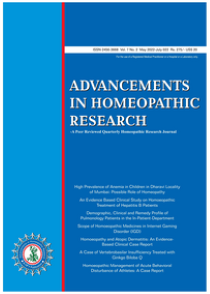Real-World Evidence on the Effectiveness of Zauber™ Hair Drops in Managing Hair Fall and Alopecia: A Post-Marketing Survey
DOI:
https://doi.org/10.48165/ahr.2025.10.2.1Keywords:
Alopecia, Hair Fall, Homeopathy, Zauber™ Hair Drops, Post-Marketing Survey, Androgenetic Alopecia, DHT, Herbal Formulation, Integrative DermatologyAbstract
condition with multifactorial etiology, including hormonal imbalance, nutritional deficiencies, stress, and environmental triggers. Despite the availability of conventional therapies, their limitations have led to increasing interest in alternative and homeopathic solutions. This study aimed to evaluate the real world effectiveness and physician satisfaction associated with Zauber™ Hair Drops, a homeopathic formulation, in the management of hair fall and alopecia.Materials & Methods: A post-marketing survey was conducted using a structured Google Form circulated among various healthcare channels including practitioners, dealers and end consumers across India for diversified responses. The survey collected data on indications treated, onset of clinical improvement, perceived effectiveness, patient outcomes, and any reported adverse events. Descriptive analysis was performed on the physician responses. Results: A total of 38 responses were received from the survey out of which majority of participation was from clinical practitioners. Of the 24 participating physicians, 87.5% prescribed Zauber™ for hair fall, with the remainder using it for scalp concerns like dandruff or irritation. Approximately 79.2% rated its effectiveness between 4 and 5 on a 5-point scale, while 80% observed clinical improvement within two weeks of use. Notably, 91.7% of doctors expressed willingness to recommend the product. No adverse effects were reported. These findings are supported by preclinical studies demonstrating anti-androgenic activity and hair follicle stimulation in a testosterone induced alopecia model. Conclusion: Zauber™ Hair Drops had high physician satisfaction and positive therapeutic effects for treating chronic hair loss and scalp diseases. Its properties like targeted and rapid action, good tolerability, and natural multi-targeted strategy makes it a viable alternative to conventional therapies.
References
1. Cash, T. F. (1992). The psychological effects of androgenetic alopecia in men. Journal of the American Academy of Dermatology, 26(6), 926- 931.
2. Oiwoh, S. O., Enitan, A. O., Adegbosin, O. T., Akinboro, A. O., & Onayemi, E. O. (2024). Androgenetic alopecia: A review. Nigerian Postgraduate Medical Journal, 31(2), 85-92.
3. Messenger, A. G., & Sinclair, R. (2006). Follicular miniaturization in female pattern hair loss: clinicopathological correlations. British Journal of Dermatology, 155(5), 926-
930.
4. Alyoussef A. (2020). Survey of use of herbal and home remedies for hair and scalp among women in North West Saudi Arabia. Dermatology reports, 12(2), 8651. https://doi.org/10.4081/ dr.2020.8651
5. Hamilton, J. B. (1951). Patterned loss of hair in man: types and incidence. Annals of the New York Academy of Sciences, 53(3), 708-728.
6. Singal, A., Sonthalia, S., & Verma, P. (2013). Female pattern hair loss. Indian Journal of Dermatology, Venereology and Leprology, 79, 626.
7. Sawaya, M. E., & Price, V. H. (1997). Different levels of 5α-reductase type I and II, aromatase, and androgen receptor in hair follicles of women and men with androgenetic alopecia. Journal of Investigative Dermatology, 109(3), 296-300.
8. Olsen, E. A. (2003). Current and novel methods for assessing efficacy of hair growth promoters in pattern hair loss. Journal of the American Academy of Dermatology, 48(2), 253-262.
9. Dias, M. F. R. G., Loures, A. F., & Ekelem, C. (2021). Hair cosmetics for the hair loss patient. Indian Journal of Plastic Surgery,
54(04), 507-513.
10. Finner, A. M. (2013). Nutrition and hair: deficiencies and supplements. Dermatologic clinics, 31(1), 167-172.
11. Tkachenko, E., Okhovat, J. P., Manjaly, P., Huang, K. P., Senna, M. M., & Mostaghimi, A. (2023). Complementary and alternative medicine for alopecia areata: A systematic review. Journal of the American Academy of Dermatology, 88(1), 131-143.
12. Bell, I. R., & Koithan, M. (2012). A model for homeopathic remedy effects: low dose nanoparticles, allostatic cross-adaptation, and time-dependent sensitization in a complex adaptive system. BMC complementary and alternative medicine, 12, 1-21.
13. Boericke, W. (2002). Pocket manual of homoeopathic Materia Medica & Repertory: comprising of the characteristic and guiding symptoms of all remedies (clinical and pahtogenetic [sic]) including Indian Drugs. B. Jain publishers.
14. Allen, T. F., HERING, C., & Hughes, R. (1874). The Encyclopedia of Pure Materia Medica. A Record of the... Effects of Drugs Upon the Healthy Human Organism. Edited by TF Allen... With Contributions from... R. Hughes... C. Hering, Etc. New York, Philadelphia.
15. Aphale, P., Dalua, S. S., Tiwari, P., Valavan, R.. An Innovative Approach to Hair Regeneration: Synergistic Effects of Zauber™ Hair Drops and Zauberöl® Premium Hair Oil in Testosterone
Induced Alopecia Rat Model. ADVANCEMENTS IN HOMEOPATHIC RESEARCH.
16. Sherman, R. E., Anderson, S. A., Dal Pan, G. J., Gray, G. W., Gross, T., Hunter, N. L., ... & Califf, R. M. (2016). Real-world evidence—what is it and what can it tell us. N Engl J Med, 375(23), 2293-2297.
17. Makady, A., van Veelen, A., Jonsson, P., Moseley, O., D’Andon, A., de Boer, A., ... & Goettsch, W. (2018). Using real-world data in health technology assessment (HTA) practice: a comparative study of five HTA agencies. Pharmacoeconomics, 36, 359-368.




